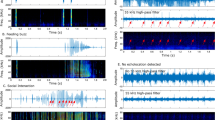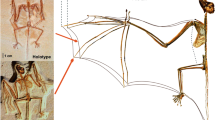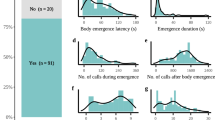Abstract
Arising from: N. Veselka et al. Nature 463, 939–942 (2010)10.1038/nature08737; Veselka et al. reply
Laryngeal echolocation, used by most living bats to form images of their surroundings and to detect and capture flying prey1,2, is considered to be a key innovation for the evolutionary success of bats2,3, and palaeontologists have long sought osteological correlates of echolocation that can be used to infer the behaviour of fossil bats4,5,6,7. Veselka et al.8 argued that the most reliable trait indicating echolocation capabilities in bats is an articulation between the stylohyal bone (part of the hyoid apparatus that supports the throat and larynx) and the tympanic bone, which forms the floor of the middle ear. They examined the oldest and most primitive known bat, Onychonycteris finneyi (early Eocene, USA4), and argued that it showed evidence of this stylohyal–tympanic articulation, from which they concluded that O. finneyi may have been capable of echolocation. We disagree with their interpretation of key fossil data and instead argue that O. finneyi was probably not an echolocating bat.
Similar content being viewed by others
Enjoying our latest content?
Log in or create an account to continue
- Access the most recent journalism from Nature's award-winning team
- Explore the latest features & opinion covering groundbreaking research
or
References
Fenton, M. B. Echolocation: implications for ecology and evolution of bats. Q. Rev. Biol. 59, 33–53 (1984)
Moss, C. F. & Surlykke, A. Auditory scene analysis by echolocation in bats. J. Acoust. Soc. Am. 110, 2207–2226 (2001)
Simmons, N. B. & Geisler, J. H. Phylogenetic relationships of Icaronycteris, Archaeonycteris, Hassianycteris, and Palaeochiropteryx to extant bat lineages, with comments on the evolution of echolocation and foraging strategies in Microchiroptera. Bull. Am. Mus. Nat. Hist. 235, 1–182 (1998)
Simmons, N. B., Seymour, K. L., Habersetzer, J. & Gunnell, G. F. Primitive early Eocene bat from Wyoming and the evolution of flight and echolocation. Nature 451, 818–821 (2008)
Novacek, M. J. Evidence for echolocation in the oldest known bats. Nature 315, 140–141 (1985)
Novacek, M. J. Auditory features and affinities of the Eocene bats Icaronycteris and Palaeochiropteryx (Microchiroptera, incertae sedis). Am. Mus. Novit. 2877, 1–18 (1987)
Habersetzer, J. & Storch, G. Cochlea size in extant Chiroptera and middle Eocene Microchiroptera from Messel. Naturwissenschaften 79, 462–466 (1992)
Veselka, N. et al. A bony connection signals laryngeal echolocation in bats. Nature 463, 939–942 (2010)
Mason, M. J. Evolution of the middle ear apparatus in talpid moles. J. Morphol. 267, 678–695 (2006)
Griffiths, T. A., Truckenbrod, A. & Sponholtz, P. J. Systematics of megadermatid bats (Chiroptera, Megadermatidae), based on hyoid morphology. Am. Mus. Novit. 3041, 1–21 (1992)
Griffiths, T. A. Phylogenetic systematics of slit-faced bats (Chiroptera, Nycteridae), based on hyoid and other morphology. Am. Mus. Novit. 3090, 1–17 (1994)
Sprague, J. M. The hyoid region of placental mammals with especial reference to the bats. Am. J. Anat. 72, 385–472 (1943)
Sprague, J. M. The hyoid region in the insectivora. Am. J. Anat. 74, 175–216 (1944)
Author information
Authors and Affiliations
Contributions
Comparative study of fossil and living bats was carried out by N.B.S. and G.F.G. MCT scanning was coordinated by J.H. and interpreted by J.H. and K.L.S. N.B.S. wrote the manuscript with contributions from J.H., K.L.S. and G.F.G.
Ethics declarations
Competing interests
Competing financial interests: declared none.
PowerPoint slides
Rights and permissions
About this article
Cite this article
Simmons, N., Seymour, K., Habersetzer, J. et al. Inferring echolocation in ancient bats. Nature 466, E8 (2010). https://doi.org/10.1038/nature09219
Received:
Accepted:
Issue date:
DOI: https://doi.org/10.1038/nature09219
This article is cited by
-
Development of the hyolaryngeal architecture in horseshoe bats: insights into the evolution of the pulse generation for laryngeal echolocation
EvoDevo (2024)
-
The vocal apparatus: An understudied tool to reconstruct the evolutionary history of echolocation in bats?
Journal of Mammalian Evolution (2023)
-
Evolution of inner ear neuroanatomy of bats and implications for echolocation
Nature (2022)
-
Evolution of Traditional Aerodynamic Variables in Bats (Mammalia: Chiroptera) within a Comprehensive Phylogenetic Framework
Journal of Mammalian Evolution (2020)
-
Evolution of Body Mass in Bats: Insights from a Large Supermatrix Phylogeny
Journal of Mammalian Evolution (2020)



